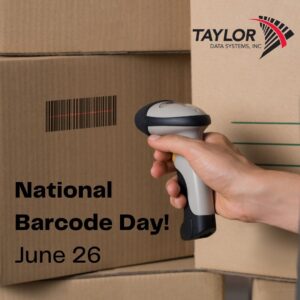 The Power of Barcode Reading Technology: Unleashing Efficiency and Innovation
The Power of Barcode Reading Technology: Unleashing Efficiency and Innovation
Today, June 26th, we celebrate National Barcode Day—a special occasion to recognize and appreciate the profound impact of barcodes and barcode reading technology. Barcode technologies have revolutionized various industries, particularly manufacturing, warehouse management, and logistics. With their ability to store and retrieve vast amounts of information quickly and accurately, barcodes have streamlined processes, increased efficiency, and minimized errors. This blog post traces the history and evolution of barcode reading technologies, focusing on barcode scanners, mobile computers, and mobile tablets, and their impact on these industries.
The Birth of Barcodes and Early Barcode Scanners
In the early 1970s, barcodes emerged as a means to improve inventory control and automate data capture. The first standardized barcode, the Universal Product Code (UPC), was introduced in 1974. Initially, barcode scanning was performed using dedicated laser-based scanners that required direct line-of-sight contact with the barcode. These early scanners used helium-neon lasers and photomultiplier tubes, but they were limited by their bulkiness and high cost.
Advancements in Barcode Scanners
Linear Imagers and CCD Scanners: In the late 1980s and early 1990s, linear imagers and charge-coupled device (CCD) scanners gained popularity. These scanners used an array of light-sensitive elements to capture barcode images, eliminating the need for a laser. Linear imagers were particularly useful for scanning damaged or poorly printed barcodes.
Laser Scanners and 2D Area Imagers: As technology advanced, laser scanners became smaller, more affordable, and capable of reading barcodes from greater distances. In the 1990s, laser scanners gained prominence due to their superior scanning range and precision. Additionally, 2D area imagers were introduced, enabling the reading of both traditional linear barcodes and two-dimensional barcodes like code 49 and PDF417.
The Rise of Mobile Computers
Integration of Barcode Scanning: With the advent of mobile computing, barcode scanning functionality began to be integrated into handheld devices. This eliminated the need for separate barcode scanners, reducing costs and enhancing portability. Mobile computers offered real-time data capture, processing, and communication, making them indispensable in warehouse and logistics operations.
Operating Systems and Software Solutions: Mobile computers evolved to incorporate powerful operating systems like Windows CE, Android, and iOS, enabling the development of custom applications for diverse business needs. These devices integrated Wi-Fi, cellular connectivity, and Bluetooth, allowing seamless communication with enterprise systems, databases, and other peripherals.
The Emergence of Mobile Tablets
Larger Screens and Enhanced Functionality: Mobile tablets with built-in barcode scanning capabilities entered the scene, providing larger screens and improved user interfaces. Their versatility made them ideal for inventory management, order picking, and other warehouse operations. Tablets offered additional functionalities like image capture, signature capture, and document viewing, further enhancing their utility in logistics and supply chain management.
Ruggedness and Durability: Recognizing the need for durability in demanding industrial environments, ruggedized tablets were developed. These devices featured reinforced casings, resistance to dust, water, and extreme temperatures, making them suitable for tough warehouse and logistics settings.
Take Advantage of New Barcoding Technology
The history of barcode reading technologies in manufacturing, warehouse, and logistics has witnessed remarkable advancements. From the early laser scanners to linear imagers, CCD scanners, and 2D area imagers, barcode scanners have become more compact, accurate, and versatile. The integration of barcode scanning capabilities into mobile computers and tablets has further revolutionized these industries, providing real-time data capture, enhanced connectivity, and improved user experiences. As technology continues to advance, we can expect even more sophisticated and efficient barcode reading solutions to reshape the future of manufacturing, warehousing, and logistics.
Since the 1980’s Taylor Data Systems has worked within the manufacturing, warehousing, logistics, and healthcare industries to understand process workflows and technology systems to ensure the best barcoding configurations for improved performance and efficiency. Contact Taylor Data Systems today to discuss the various barcoding technologies available for your industry and how they can be used to boost your operations.





